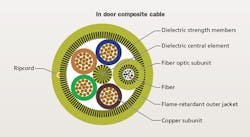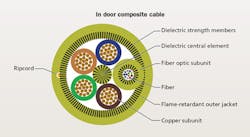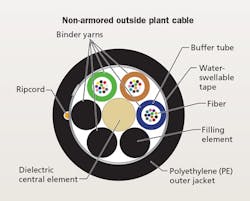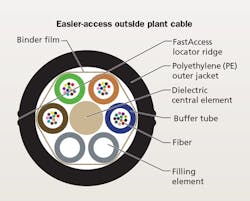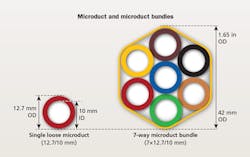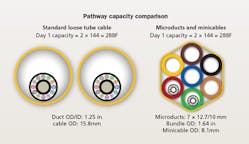Innovations include more-convenient ways to access cable, and the use of microducts.
By Matthew Miller, Corning Optical Communications
Traditionally fiber-optic cable was reserved for long-haul applications, enabling voice and data transmissions to cross continents and seas. As personal computers and the internet gained traction as a part of daily life and business, fiber-optic infrastructure needed to extend deeper into networks—all the way indoors.
This shift in fiber’s use from an exclusively long-distance, outdoor medium to campus backbones, then indoor riser backbones, and now the building horizontal challenged cable manufacturers to develop solutions for new environments. Over the years, the resulting cable designs and installation technologies have addressed bandwidth demand, distance constraints, deployment hurdles, and cost considerations.
These factors remain the same in today’s cable evolution, but the drivers have changed.
Mobility—Businesses benefit when employees can collaborate and maintain connectivity wherever they meet and work. Mobility is a key enabler for collaboration, so it is not surprising that WiFi use in the enterprise is on the rise. Infonetics reports that 52 percent of today’s employees work exclusively over WiFi, and the figure is expected to reach 65 percent by 2019. The 2017 Cisco Visual Networking Index (Cisco VNI) says, “By 2021, wired devices will account for 37 percent of IP traffic, while WiFi and mobile devices will account for 63 percent.” Clearly the trend is for devices to connect and interact with the network access layer in a wireless fashion.
Internet of Things—At its core, the Internet of Things (IoT) is a concept describing what happens when the cost of computing and networking becomes so small that almost any object can be imbued with these capabilities. The sheer number of devices able to connect to the network wirelessly is increasing at a much faster rate than wired devices. For example, Infonetics reports in the 2017 WLAN Strategies North America Enterprise Survey that “respondents expect their installed base of IP desk phones, smartphones, tablets, laptops, and desktop PCs to grow by more than 30 percent by 2019. Mobile devices (smartphones, tablets, and laptops) will grow at over twice the rate of tethered devices.”
Cloud computing—The “cloud” is basically a data center located offsite that hosts computing and storage resources important for downstream devices. The use of the cloud is increasing as it allows employees to work from any location while having easy access to relevant applications and data. Infonetics says, “In past years cloud apps were not a major WiFi traffic contributor, but that finally changed in 2017, with cloud now among the top three drivers.” This study confirms the cloud’s role as a significant driver for future technologies—and it means the cloud is an important factor in the development of cable technology.
How drivers impact cable technology
As companies go through hardware-upgrade cycles to stay competitive in the marketplace, they take advantage of trends such as mobility, IoT, and the cloud. Ultimately they are looking for ways to lower costs and risks for long-term success. Often enterprises focus on the electronics such as switching and routing for their upgrades; but it is important to remember the cabling infrastructure to prevent any weak links in the network, either inside or outside the building.
Cabling technology has certainly evolved over time to support new network requirements. For example, copper conductors and fiber have been combined into single composite cable for remote power and communications; applications include cameras, distributed antenna systems, and remote switches. This new composite cable is capable of spanning greater distances and delivering higher wattage than Power over Ethernet (PoE).
The dominant method for remote powering in the building horizontal, PoE uses copper cable. IEEE 802.3af and 802.3at specify that power sourcing equipment, such as a 48-port switch, supply 15.4 and 30 W respectively from a switch port. Cisco switches have the capability to supply up to 60 W using a proprietary method called Universal Power over Ethernet (UPOE). 802.3bt is currently in development and is expected to be published in 2018. It specifies up to 90 W coming from a source port.
Voice over Internet Protocol (VoIP) phones and WiFi access points that enable mobility, IoT, and cloud are the main users of PoE technology, but other applications include LED lighting, digital signage, building controllers, and access control, to name a few. The maximum length for PoE on unshielded twisted pair is 90 meters with 5-meter jumpers on both sides of the channel, totaling 100 meters.
Composite cable is another way to provide remote power. Containing copper conductors and optical fiber, this cable design provides communication capability to user devices via fiber, and it includes copper pairs for remote powering. Composite cables can be used for devices that are unable to accept PoE connections, when a device needs remote powering but is >100 meters from the power source equipment, or even when >100 W is needed to the powered device while also remaining as Class 2 power.
Handling and access improvements
In addition to developing innovation around communications and power cable, it is important to improve the craft-friendliness of optical cables. Innovation has continued with outside plant cable design focusing on improving cable access speed and reducing risk of installer injury or fiber damage.
Traditional outside plant cables require the use of hook blades and other sharp instruments for removal of the jacket, binder yarns, waterblocking tape, and ripcords before gaining access to the buffer tubes. This process can be time-consuming and pose a risk for installers if not properly trained. New innovations have come along to make cable access faster with fewer tools while also making access safer.
The figure on the opposite page shows the addition of an access feature embedded in the jacket. Corning calls this feature the FastAccess technology locator ridge. It introduces two seams at the opposite sides of the cable that make access possible using only a pair of needle-nose pliers. Gone are the hook blades that can cause injury to the technician and/or cause damage to the fiber within the buffer tubes. Second, ripcords that are used in traditional non-armored cable designs have been eliminated. This simplified cable design removes a step in the cable access procedure, saving time. Third, individual binder yarns were replaced with a binder film. Unlike binder yarns, binder film is removed during the jacket removal step in the cable access process. This improvement also eliminates the need for the seam ripper, further streamlining the process. Fourth, the new technology removes water-swellable tape and replaces it with waterblocking powder inside the buffer tubes—yet another step eliminated from the cable access process.
These four improvements acting together can make cable access faster and safer, while maintaining current mechanical standards. Our tests have shown that access time has been reduced by 40 to 70 percent on cables with FastAccess technology versus traditional cable jackets.
Microduct and microduct-optimized cable
When designing new systems or adding to old ones, it is important to consider the cable pathways and how you will plan for future network speeds. For example, it can be almost or completely impossible to add more cable after the initial install in a traditional duct system, making it difficult to scale. In addition, network owners want to avoid congested ducts, because adding additional duct capacity can be expensive and disruptive.
Microduct solves the challenge of congested ducts by ensuring precious duct space is used as efficiently as possible. Microduct bundles can subdivide existing pathways, efficiently using the space by adding pathways up front. This approach enables lower installation costs for moves, adds, and changes. The figure above depicts day-one duct capacity with equivalent fiber counts between standard loose tube and microduct-optimized cable. Within their compartmentalized spaces, individual cables are physically separated, reducing the likelihood of cable-on-cable damage. Cable installed in the microduct can also be removed once installed and used elsewhere (which is an improvement on traditional duct’s limitations).
Microduct from 3.5 to 14 mm in size can be installed in occupied ducts, bundled together and installed as a group into existing duct or as duct by themselves, and even direct buried. Flame-rated versions are also available.
To take full advantage of microduct’s many benefits, microduct-optimized cable is needed. Compared to standard loose tube cable, microduct-optimized cable is smaller in diameter because there is no longer a need for the mechanically robust design features of standard telecommunications cable. The microduct now provides the mechanical protection for microduct-optimized cables. Just because the cable is smaller doesn’t mean fiber counts are reduced as well. On the contrary, microduct cable can have 100 to 200 percent more fibers than standard cable. Combined, microduct-optimized cable and microduct increases fiber density within the same footprint and allow for more cost-effective moves, adds, and changes.
Microduct-optimized cable’s reduced mechanical robustness includes a reduction in tensile strength that make air-assisted installation a requirement. The benefits of air-assisted deployment versus traditional pulling methods include smaller installation crews, faster installation, and longer distances. For short distances, microduct-optimized cable can simply be pushed in without air-assistance.
There are situations in which adding cables in certain indoor environments can be disruptive to operations. For example, to install new cable above a plant floor may require shutting down production equipment while the installation of new cable is carried out overhead. In airports, people are constantly in terminals and gates, making it difficult to install new cable overhead. Both situations present challenges using traditional pulling methods. Once microduct is installed, accessing the ceiling would almost be unnecessary. Pulling in a microduct bundle once and then coming back later to install new cable as needed, without disrupting the floor area, eliminates downtime and loss of revenue.
As network upgrade planning occurs to address changing needs derived from mobility, IoT, and cloud drivers, network owners must stay abreast of new technologies to successfully compete in the market. No matter what driver is impacting the enterprise, the challenges of dynamic bandwidth demand, distance constraints, installation challenges, and cost management remains constant.
Consider cable technologies that provide remote power and communications over greater distances and wattages when utilizing PoE. When searching for ways to reduce labor cost, installation time, and risk, look for cabling that utilizes features like FastAccess technology. If you are addressing duct space congestion, planning for future cable pathways, and reducing operations disruption, consider using microduct-optimized cables. Leveraging new cabling technologies in your next installation is a strategic investment that strengthens the enterprise network.
Matthew Milleris portfolio manager for global enterprise networks with Corning Optical Communications.
